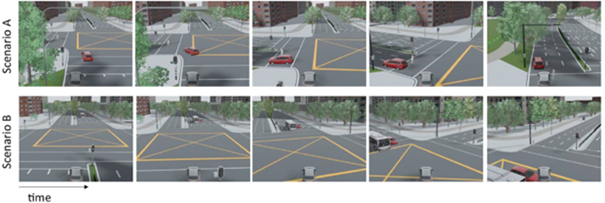Safe road design: Siemens and Roadscor support Vision Zero through traffic engineering innovation

As cities grow and transportation systems evolve, ensuring the safety of road users has become a critical challenge. Vulnerable road users, especially pedestrians and cyclists, are particularly at risk, emphasizing the need for innovative solutions in road design. Addressing this challenge head-on, Siemens Digital Software Industries and Roadscor have embarked on a collaboration aimed at revolutionizing road safety analysis and infrastructure planning.
This partnership aligns with the global Vision Zero initiative—a bold ambition to eliminate traffic-related fatalities and serious injuries worldwide. By combining Siemens advanced simulation technologies with Roadscor expertise in safety analysis, the collaboration seeks to provide traffic engineers with more accurate and complete tooling for safety in urban infrastructure design.
The challenge: designing for safety in a complex world
Modern urban mobility involves a complex interplay of vehicles, pedestrians, cyclists, and public transit systems. Designing infrastructure that ensures the safety of all these users requires a proactive, data-driven approach. Traditional methods, often reliant on historical accident data, are no longer sufficient to predict and mitigate risks in today’s dynamic environments.
Roadscor is dedicated to improving safety outcomes by analyzing the risks associated with old and new road designs. To enhance this process, Siemens brings a suite of cutting-edge tools and methodologies to the collaboration, enabling more accurate predictions of potential hazards.
Siemens advanced tools: the foundation for safer roads
Siemens contribution to this partnership includes its patented Critical Scenario Creation methodology, along with the Simcenter Prescan and Simcenter HEEDS software. These technologies, already used globally in the automotive industry, are now being introduced to traffic and infrastructure engineering for the first time through this collaboration.
1- Critical Scenario Creation
- Siemens patented methodology focuses on identifying the most critical and high-risk scenarios that could lead to unsafe outcomes on the road.
- Widely adopted by automotive engineers to design and test Advanced Driver Assistance Systems (ADAS) and Autonomous Vehicle (AV) systems, this methodology has proven instrumental in enhancing vehicle safety.
- Now applied to infrastructure design, it enables planners to address the most significant safety conflicts before (re-)construction begins.

2 – Simcenter Prescan
- Simcenter Prescan is a simulation platform that models complex traffic environments and interactions.
- Used extensively in the automotive sector to create virtual prototypes of ADAS and AV systems under various conditions.
- With this partnership, Simcenter Prescan is now applied to create digital twins of road designs, allowing for testing under diverse scenarios, including traffic flow variations, weather changes, and lighting conditions.
- It offers insights into how infrastructure performs, identifying potential hazards that haven’t happened yet and might not be evident through traditional design processes.
3 – Simcenter HEEDS
- Simcenter HEEDS (Hierarchical Evolutionary Engineering Design System), traditionally used in automotive engineering for design optimization, is now applied in traffic engineering to identify unknown-unsafe scenarios as defined by the Safety of the Intended Functionality (SOTIF) standard.
- By exploring countless configurations and stress tests, Simcenter HEEDS uncovers edge cases that may pose safety risks, enabling engineers to address them proactively.

Bridging automotive and infrastructure safety
For years, Siemens technologies have supported the development of safe, reliable ADAS and AV systems in the automotive industry. These tools have set the standard for identifying and addressing critical safety scenarios, enabling automakers to design vehicles that adapt to complex environments.
Through this partnership with Roadscor, these same proven technologies are being adapted to the world of traffic and infrastructure engineering. This represents a paradigm shift, bringing the rigor and precision of automotive safety testing to the planning and design of urban environments in support of the experience and expertise of traffic engineers.
A proactive approach to safety
The integration of these technologies represents a shift from reactive to proactive safety analysis. Instead of relying on historical crash-data or road observations to address issues, Siemens and Roadscor are bringing safety considerations to the forefront of the design process.
This approach not only aligns with Vision Zero but also supports the broader need for sustainable, efficient urban development. By ensuring that safety is a core aspect of infrastructure planning, cities can reduce fatalities and serious injuries while fostering environments that support active and sustainable transportation modes.
Shaping the future of urban mobility
The future of urban mobility is not only about efficiency and convenience but also about ensuring that every road user arrives at their destination safely. The partnership between Siemens DI Software and Roadscor B.V. represents a significant step toward this goal.
By leveraging Siemens advanced simulation tools and methodologies, Roadscor is poised to deliver safety analyses that are more comprehensive, accurate and predictive than ever before. Together, they are setting a new benchmark for integrating safety into infrastructure design.
A call to action
As the collaboration progresses, it serves as a call to action for governments, engineering firms, and urban planners to prioritize safety in their projects. Embracing technologies like those provided by Siemens and Roadscor can ensure that road designs meet the demands of modern mobility without compromising safety.
With Vision Zero as a guiding principle, the Siemens & Roadscor partnership is paving the way for a future where traffic-related fatalities and injuries are a thing of the past.
For more information, please contact Gwen Van Vugt, Head of Simcenter Autonomy.
Further reading
For those interested in delving deeper into the technologies underpinning Siemens solutions, we refer to the papers listed below. These documents provide valuable insights into the methodologies and frameworks that make Siemens offerings so advanced and effective.
- ATZ Paper: Tool Chain for the Virtual Validation of Autonomous Vehicles. Authors: M. Alirezaei, A. Forrai, T. Singh, S. Tong, J. Ploeg. Source: ATZ worldwide 126 (9), 16–21
- SAE Paper: A Systematic Approach for Creation of SOTIF’s Unknown Unsafe Scenarios: An Optimization-based Method. Authors: T. Singh, E. van Hassel, A. Sheorey, M. Alirezaei. Source: SAE Technical Paper
- ITSC Paper: Unknown-Unsafe Scenario Generation for Verification and Validation of Automated Vehicles. Authors: N. Rajesh, E. Van Hassel, M. Alirezaei. Conference: 2023 IEEE 26th International Conference on Intelligent Transportation Systems (ITSC)


